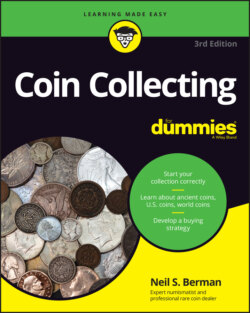Читать книгу Coin Collecting For Dummies - Neil S. Berman - Страница 69
Keeping Them High and Dry
ОглавлениеMoisture is a coin’s worst enemy. Coins are made of metal, some of which is very chemically active. According to the laws of chemistry and physics, your coins will most certainly deteriorate over time unless you protect them.
A coin begins reacting with its environment as soon as it’s struck (made). Changes are subtle for the most part, but some changes may be significant. A copper coin’s color changes; it may corrode or oxidize. This damage often starts as a tiny spot that grows until it eventually eats into the coin’s surface. A single spot is bad enough, but poorly preserved coins may end up covered with spots and/or green corrosion. Naturally, collectors hate spots, corrosion, and coins with pitted surfaces (referred to as pitting). Unless the coin is a great rarity, such damage destroys any collector value.
Silver and gold coins are just as susceptible to chemical reactions. Over time, silver will tarnish or tone, resulting in a film of color that can range from light and subtle to dark and unattractive. Gold is relatively inert, but most gold coins include a small percentage of copper, which is a very sensitive metal.
Many of the chemical reactions that occur on the surface of a coin require, or are accelerated by, water. Simply put, water kills coins. Moisture of any kind should be avoided at all cost. If you live in an area of high humidity or ocean spray, protecting your coins becomes more difficult and important.
Still, you can do several things to ensure that your coins remain as pristine and as beautiful as they were the day you bought them.
